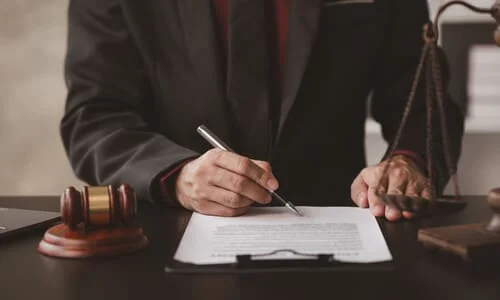
Negligence is a legal concept that refers to the failure to exercise a reasonable standard of care in a given situation, which resulted in harm or injury to another person (or their property).
Determining negligence is especially important in personal injury lawsuits because it can help establish whether or not the defendant acted in a way that caused harm (called damages) to the plaintiff.
Ultimately, to succeed in a personal injury lawsuit, the plaintiff must typically prove that the defendant was negligent. If they can prove negligence, they may be entitled to compensation for the damages they suffered after the relevant accident.
If you’re looking for an expert legal team to review your case and help you establish the best next steps in your case, turn to Singh Ahluwalia Attorneys at Law. Our California personal injury lawyers can provide a confidential, no-obligation case review to help you learn your rights.
All you have to do is call (559) 878-4958 or contact us online to schedule your appointment today.
Examples of Negligence
“Negligence” may sound formal, but it is actually a more common occurrence than you might think. Here are five examples of negligence that may result in legal action:
- Medical malpractice: When a healthcare professional fails to provide proper care or treatment, resulting in injury or harm to the patient. For example, a surgeon operating on the wrong body part, a nurse administering the wrong medication, or a doctor failing to diagnose a serious condition could all result in a lawsuit.
- Slip and fall accidents: When someone is injured due to a property owner’s failure to maintain a safe environment, such as failing to fix a broken staircase, not cleaning up a spill in a timely manner, or failing to put up warning signs.
- Car accidents: When a driver fails to exercise reasonable care while operating a vehicle, and their actions result in an accident and injuries to other drivers, passengers, or pedestrians. For example, if they’re driving under the influence of alcohol or drugs, texting while driving, or failing to obey traffic signals, you may be able to hold them accountable.
- Product liability: When a defective or dangerous product causes injury or harm to a consumer. For example, a car with faulty brakes or a defective medical device that causes harm to a patient.
- Premises liability: When a property owner fails to maintain their property in a safe condition, and it results in injury or harm to their visitors. For example, a major injury at an improperly maintained private swimming pool or a dog bite injury at a park due to the owner’s failure to control their dog.
What Is the Standard of Ordinary Care?
The standard of ordinary care is the level of care that a reasonable person or entity would exercise in similar circumstances to prevent harm to others. In other words, it is the level of care that a responsible and prudent person would take to avoid causing harm to others.
The standard of ordinary care is an important concept in negligence law because it establishes the duty of care that the defendant (the person or entity being sued) owes to the plaintiff (the person who suffered the injury or loss).
What Is Duty of Care?
Duty of care is the requirement that a person acts towards others (and the public) with the caution that any reasonable person in their circumstances would adopt. Essentially, a person’s ‘duty of care’ is the expectation that they will administer the right amount of care or caution.
The person’s duty will differ depending on their relationship to the injured plaintiff. Bus drivers and health care providers, for example, have higher standards of care according to the expectations of their profession as well as any relevant laws, rules, and regulations.
So in effect, to prove negligence, the plaintiff must show that the defendant breached their duty of care by failing to meet the standard of care and that this breach caused harm to the plaintiff.
What Is Standard of Care in a Medical Case?
Malpractice cases involve professional negligence, which requires looking into the specific standards that a professional is expected to comply with.
In some cases, a person may have taken an action (or failed to take an action) that led to harm to the plaintiff but still followed all acceptable standards in the process. Any deviation from those professional standards of care, resulting in harm, could constitute malpractice.
What Are the Different Types of Negligence?
In most cases, a legal team is looking at ordinary negligence, which is simply a situation that occurs when a person or entity fails to exercise reasonable care in their actions (or omissions). So, for example, if a driver fails to stop at a red light, we’d call this ordinary negligence.
That said, there are several other types of negligence that may come into play.
Gross Negligence
This is a higher level of negligence that involves a more reckless disregard for the safety of others. It occurs when a person or entity acts with complete indifference (or conscious disregard) for the safety of others.
For example, a doctor who performs a surgery while intoxicated may be liable for gross negligence, as could a company that explicitly encourages its drivers to speed in order to make delivery times shorter.
Comparative Negligence
This legal principle that applies when both parties in an accident or injury claim share some degree of fault. Under comparative negligence, damages may be reduced based on the percentage of fault assigned to each party.
Contributory Negligence
This concept applies in some states and bars recovery for a plaintiff if they were partially at fault for their own injuries. Under this doctrine, if the plaintiff contributed to their own injuries in any way, they may not recover any damages from the defendant.
Luckily, California is a comparative negligence state (that does not use contributory negligence), so while a plaintiff’s recovery may be reduced if they are also found at fault, they can still recover some damages — as long as their percentage of the fault is less than 50%.
Vicarious Negligence
Vicarious Negligence is used to hold an employer or principal liable for the negligent actions of their employee or agent. If a truck driver causes an accident while on the job, their employer may be vicariously liable for any injuries or damages caused by the driver’s negligence.
What Are the Elements of Negligence?
In any personal injury lawsuit, the ‘elements of negligence’ must be established to prove a claim of negligence.
- Duty: The defendant must owe a legal duty of care to the plaintiff.
- Breach: The defendant must have breached the duty of care owed to the plaintiff.
- Causation: The defendant’s breach of duty must have been the actual and proximate (most-direct) cause of the plaintiff’s injuries or damages. This means that the plaintiff’s injuries or damages must have been a direct result of the defendant’s actions or omissions.
- Damages: The plaintiff must have suffered actual damages as a result of the defendant’s breach of duty. This means that the plaintiff must have incurred some measurable harm, such as physical injury, property damage, or financial losses.
What Is Liability in a Negligence Case?
Liability in a negligence case refers to the defendant’s legal responsibility to pay for the damages or injuries the plaintiff suffered as a result of the defendant’s negligence. It can take different forms depending on the circumstances of the case.
For example, in a traditional car accident case in Fresno and throughout California, the defendant driver may be found liable for the plaintiff’s injuries and damages and then may be responsible for paying compensation to the plaintiff for medical expenses, lost wages, pain and suffering, and any other damages.
What if More Than One Party Acted Negligently?
In some situations, more than one party may be found liable for the plaintiff’s damages. If there are multiple defendants — and each can be found to have been negligent and thus have caused the plaintiff’s injuries, they may all be held responsible.
So, for example, picture a car accident in which three cars collide at an intersection because two of the drivers ran a red light.
There, if a passenger in one of the cars is injured in the accident, they may end up filing a personal injury lawsuit against both drivers for their respective roles in the accident.
In this case, a court may find that both drivers were negligent and that each driver’s negligence contributed to the passenger’s injuries. The court may then apportion liability between the drivers based on the degree of fault for the accident.
Let’s suppose that one driver was 60% at fault for running the red light, and the other driver was 40% at fault for failing to notice the red light. Each driver may be responsible for paying a portion of the passenger’s damages based on their degree of fault.
Who Decides Whether Someone is Liable Because of Negligence?
According to the American Bar Association, after a judge or jury is presented with evidence in a personal injury case, they “will decide what an ordinary person would have done in similar circumstances.”
What’s key in this process is that fault is not finalized until this type of decision or jury ruling is handed down. Most cases don’t proceed to this stage, instead settling through negotiations.
Because of this trend, what’s important is to convince the opposing party that there is a high chance of them being found negligent in a trial outcome. The higher the chance of that finding, the more likely they are to settle quickly — and for a higher amount.
How Can I Hold Someone Responsible If Their Negligence Resulted in an Injury or Damaged Property?
The best way to hold someone accountable for their negligence is to file a personal injury or property damage claim against them.
To do this, you will need to show that the other person owed you a duty of care, that they breached that duty by acting negligently, and that their negligence caused your injury or property damage.
In either case, it will be important to have the full backing of a qualified Fresno personal injury lawyer. So if you’re looking to get the ball rolling, consider reaching out to Singh Ahluwalia Attorneys at Law today.
Our California legal team can help you learn your options in a confidential, no-obligation case review. All you have to do is call (559) 878-4958 or contact us online to schedule your appointment today.


